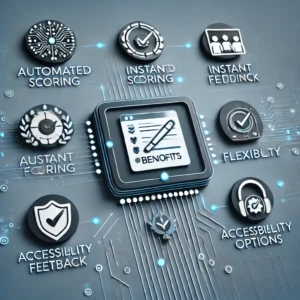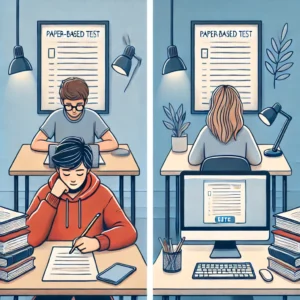In today's world, technology has transformed almost every aspect of our lives, including how we take tests. If you’ve ever sat down at a computer to answer exam questions, you’ve experienced the growing trend of computer-based testing (CBT). This method is quickly replacing traditional paper exams, and for good reason. Let’s dive into what CBTs are, how they work, and why they’re becoming the go-to choice for schools, universities, and certification programs.
What is a Computer-Based Test (CBT)?
In simple terms, a computer-based test is exactly what it sounds like: a test you take on a computer instead of on paper. Everything from the questions to your answers, and sometimes even your results, is handled digitally. These tests are becoming more common in schools, universities, and professional certification programs because they make the whole process faster and easier.
How Does a Computer-Based Test Work?
If you’re wondering how this all works, it’s pretty straightforward:
- First, you register for the exam—usually online.
- On test day, you log in to a secure system that presents your exam.
- You’ll answer the questions by typing or clicking, depending on the format.
- Once you finish, the test is either scored instantly, or if there are essay questions, it might take a bit longer to get your results.
Some CBTs are taken at designated testing centers, while others can be done right from your home if they have proper security measures in place.
Features of Computer-Based Tests

CBTs aren’t just about shifting from paper to screen. They come with a bunch of useful features:
- Automated Scoring: For multiple-choice questions, your results can be ready as soon as you click “submit,” no waiting required.
- Randomized Questions: To reduce cheating, Computer Based Tests can shuffle questions or pull from a larger pool, so everyone’s test is a little different.
- Timed Sections: CBTs often manage time more strictly, with each section automatically closing when your time is up.
- Accessibility Options: Need bigger text? Prefer to use a screen reader? CBTs can be customized to help people with different needs.
- Interactive Questions: Some exams go beyond simple multiple-choice, using drag-and-drop or other interactive elements to test your understanding.
Differences Between Paper-Based and Computer-Based Tests

Wondering what makes CBTs different from old-school paper exams? Here’s a quick comparison:
| Feature | Paper-Based Test | Computer-Based Test |
|---|---|---|
| Format | Pen and paper | Digital, on a computer |
| Scoring | Manually graded | Automatically graded for most questions |
| Timing | More flexible | Strict timing with automatic enforcement |
| Feedback | Delayed results | Often immediate |
| Accessibility | Limited options | Features like zoom, screen readers |
| Security | Monitored in person | Uses proctoring software, randomized questions |
| Environmental Impact | Requires paper and printing | Completely digital, paper-free |
Benefits of Computer-Based Tests
So, why are computer-based tests becoming the preferred option? Here are a few reasons:
- Efficiency: With automated scoring, test results are ready faster, and the whole process becomes easier to manage.
- Instant Feedback: Some tests, like multiple-choice exams, give you your score as soon as you’re done. No more waiting days or weeks!
- Flexibility: Many CBTs offer a range of test dates and times. In some cases, you can even take them from home.
- Accessibility: People with disabilities can benefit from customizable settings, like text size adjustments or screen readers, making the test-taking experience more inclusive.
Common Challenges of Computer-Based Tests
Of course, no system is perfect. There are still a few hurdles with CBTs:
- Technical Issues: A slow internet connection or a glitchy computer can really throw off your concentration during a test. Luckily, most testing centers have backup systems to prevent major disruptions.
- Test Anxiety: If you’re not super comfortable using computers, taking a test on one can feel stressful. It’s just another layer of nerves added to the usual test anxiety.
- Security Concerns: While CBTs have strong security measures like lockdown browsers and proctoring software, keeping everything secure in a digital environment is always a challenge.
Examples of Popular Computer-Based Tests
Many well-known exams have transitioned to CBT formats. For example:
-
-
GRE (Graduate Record Examination)
The GRE is a standardized test commonly required for admission to graduate schools in the U.S. and some other countries. The exam, which tests verbal reasoning, quantitative reasoning, and analytical writing, is conducted entirely online at designated testing centers. -
GMAT (Graduate Management Admission Test)
The GMAT is a computer-based exam required for admission to many business schools around the world. It evaluates skills in quantitative reasoning, verbal reasoning, integrated reasoning, and analytical writing. The exam is taken on a computer at designated centers. -
SAT (Scholastic Assessment Test)
The SAT is a standardized college admissions test in the U.S. While it has traditionally been paper-based, the College Board has been transitioning to computer-based testing in some regions, making it more accessible and flexible for students. -
LSAT (Law School Admission Test)
The LSAT is a standardized test used for law school admissions. It is now offered in a digital format, where candidates take the exam on a computer at designated centers. The exam assesses skills in reading and analytical reasoning. -
ACT (American College Testing)
The ACT is another standardized college admissions exam that is primarily taken on paper but is increasingly available in a computer-based format. It tests students on English, math, reading, and science reasoning. -
NCLEX (National Council Licensure Examination)
The NCLEX is a computer-based exam used by nursing boards in the U.S. to determine if candidates are qualified to become licensed nurses. It uses computer adaptive testing (CAT), where the difficulty of questions adjusts based on the candidate’s answers. -
MCAT (Medical College Admission Test)
The MCAT, required for admission to medical schools in the U.S., is now entirely computer-based. The exam tests knowledge in biological and physical sciences, critical thinking, and writing skills. -
TOEFL (Test of English as a Foreign Language)
The TOEFL is a computer-based test used to assess the English proficiency of non-native English speakers. It is commonly required for international students applying to U.S. colleges and universities. - JEE Main (Joint Entrance Examination)
- The National Testing Agency (NTA) conducts the JEE Main (Joint Entrance Examination), a computer-based test for aspiring engineers in India. It unlocks the doors to undergraduate engineering programs (B.Tech/B.E.) in esteemed institutions like IITs and NITs.
- NEET (National Eligibility cum Entrance Test)
- The National Eligibility cum Entrance Test (NEET) is your gateway. Traditionally paper-based, NEET is increasingly adopting computer-based testing at designated exam centers, offering students more flexibility.
- SSC CGL (Staff Selection Commission Combined Graduate Level Examination)
- For a coveted government job, crack the SSC CGL (Staff Selection Commission Combined Graduate Level Examination). The preliminary tier utilizes computer-based testing, making the large-scale recruitment process smooth and efficient.
- SSC Constable Recruitment 2024 – Online Apply
- Official Website
- IBPS PO (Institute of Banking Personnel Selection Probationary Officer Exam)
- The Institute of Banking Personnel Selection (IBPS) PO (Probationary Officer) Exam utilizes computer-based testing in its preliminary stage. Here, candidates must answer objective questions on reasoning, quantitative aptitude, and English language.
- GATE (Graduate Aptitude Test in Engineering)
- Aspiring engineers seeking postgraduate (M.Tech) programs or recruitment by Public Sector Undertakings (PSUs) can take the GATE (Graduate Aptitude Test in Engineering). This entirely computer-based exam allows candidates to answer discipline-specific questions on a digital platform.
- RBI Assistant Exam
- The RBI Assistant Exam, conducted by the Reserve Bank of India, utilizes computer-based testing in its preliminary phase. It assesses candidates' knowledge in general awareness, English language, quantitative aptitude, and reasoning abilities.
-
To Sum it Up
In the ever-evolving world of education and professional assessments, computer-based tests are paving the way for faster, more flexible, and efficient testing methods. They offer numerous benefits, from instant feedback to increased accessibility, but also come with their own challenges like technical hiccups and security concerns. As more institutions adopt CBTs, understanding how they work can help you feel more prepared and confident if you ever need to take one.





